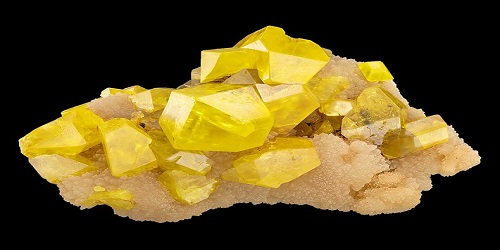Sulfur Meaning
Sulfur is the chemical element whose symbol is S and its atomic number is 16. The term comes from the Latin word sulfur.
Widespread in our planet’s crust, sulfur is characterized by its penetrating odor and yellowish color. It is found in its native state or in the form of sulfate or sulfide and is used in the pharmaceutical industry and other sectors.
Sulfur is classified as a non-metal because it does not have a good capacity for conducting heat or electricity. It is also included among the essential chemical elements because it is essential for life.
As one of the constituents of methionine and cysteine, sulfur is essential for protein synthesis. In industry, this substance is used to produce insecticides, manufacture gunpowder or as a fertilizer, for example.
It is important to mention that various compounds containing sulfur can be dangerous to health. Sulfur dioxide, hydrogen sulfide, and carbon sulfide, among others, have a high level of toxicity and can cause irritation of the mucus, bleeding, and asphyxiation.
Sulfur dioxide
Sulfur dioxide is a highly toxic, colorless gas that, when concentrated, can generate an intense odor and discomfort in the eyes, such as irritation and decreased visibility. In the Earth’s atmosphere, where it is estimated to last a few days, it combines easily with water during its oxidation, resulting in the emergence of sulfuric acid and acid rain.
It is usually produced by the combustion of fuels containing a certain amount of sulfur (such as diesel and coal). This usually occurs as a consequence of some industrial processes, coal heating, the operation of heavy vehicles, and the activity of thermal power stations. However, sulfur dioxide can also be produced by volcanic eruptions or as a result of organic decomposition.
Risks of Sulfur Dioxide
The damage that exposure to this gas can cause affects humans but also the soil, forests, seas, and other living beings in different ecosystems. In our particular case, it infiltrates the body through the nasal passages, although it also causes problems in the digestive system and eyes.
Some of the most common symptoms of exposure to sulfur dioxide are:
1. breathing problems. The rhythm is altered and it becomes more difficult
2. severe itching in the throat and nasal passages
3. cough
4. headache
5. irreversible damage to some parts of the lung
Sulfur Meaning in Hindi
सल्फर एक रासायनिक तत्व है जिसका प्रतीक S है और इसकी परमाणु संख्या 16 है। यह शब्द लैटिन शब्द सल्फर से आया है।
हमारे ग्रह की पपड़ी में व्यापक रूप से फैला हुआ, सल्फर अपनी तीखी गंध और पीले रंग के लिए जाना जाता है। यह अपने मूल रूप में या सल्फेट या सल्फाइड के रूप में पाया जाता है और इसका उपयोग दवा उद्योग और अन्य क्षेत्रों में किया जाता है।
सल्फर को एक गैर-धातु के रूप में वर्गीकृत किया गया है क्योंकि इसमें गर्मी या बिजली का संचालन करने की अच्छी क्षमता नहीं है। इसे आवश्यक रासायनिक तत्वों में भी शामिल किया गया है क्योंकि यह जीवन के लिए आवश्यक है।
मेथियोनीन और सिस्टीन के घटकों में से एक के रूप में, सल्फर प्रोटीन संश्लेषण के लिए आवश्यक है। उद्योग में, इस पदार्थ का उपयोग कीटनाशकों के उत्पादन, बारूद के निर्माण या उदाहरण के लिए उर्वरक के रूप में किया जाता है।
यह उल्लेख करना महत्वपूर्ण है कि सल्फर युक्त विभिन्न यौगिक स्वास्थ्य के लिए खतरनाक हो सकते हैं। सल्फर डाइऑक्साइड, हाइड्रोजन सल्फाइड और कार्बन सल्फाइड, अन्य के अलावा, विषाक्तता का उच्च स्तर है और बलगम की जलन, रक्तस्राव और श्वासावरोध का कारण बन सकता है।
सल्फर डाइऑक्साइड
सल्फर डाइऑक्साइड एक अत्यधिक जहरीली, रंगहीन गैस है, जो केंद्रित होने पर, तीव्र गंध और आंखों में असुविधा, जैसे जलन और दृश्यता में कमी उत्पन्न कर सकती है। पृथ्वी के वायुमंडल में, जहां यह कुछ दिनों तक रहने का अनुमान है, यह अपने ऑक्सीकरण के दौरान पानी के साथ आसानी से मिल जाता है, जिसके परिणामस्वरूप सल्फ्यूरिक एसिड और अम्लीय वर्षा होती है।
यह आमतौर पर एक निश्चित मात्रा में सल्फर (जैसे डीजल और कोयला) युक्त ईंधन के दहन से उत्पन्न होता है। यह आमतौर पर कुछ औद्योगिक प्रक्रियाओं, कोयला हीटिंग, भारी वाहनों के संचालन और थर्मल पावर स्टेशनों की गतिविधि के परिणामस्वरूप होता है। हालांकि, सल्फर डाइऑक्साइड ज्वालामुखी विस्फोटों या कार्बनिक अपघटन के परिणामस्वरूप भी उत्पन्न हो सकता है।
सल्फर डाइऑक्साइड के जोखिम
इस गैस के संपर्क में आने से होने वाला नुकसान इंसानों के साथ-साथ मिट्टी, जंगल, समुद्र और विभिन्न पारिस्थितिकी तंत्रों में रहने वाले अन्य जीवों को भी प्रभावित करता है। हमारे विशेष मामले में, यह नाक के रास्ते से शरीर में प्रवेश करता है, हालांकि यह पाचन तंत्र और आंखों में भी समस्या पैदा करता है।
सल्फर डाइऑक्साइड के संपर्क में आने के कुछ सबसे आम लक्षण हैं:
1. सांस लेने में समस्या। लय बदल जाती है और यह अधिक कठिन हो जाता है
2. गले और नाक के मार्ग में गंभीर खुजली
3. खांसी
4. सिरदर्द
5. फेफड़ों के कुछ हिस्सों को अपरिवर्तनीय क्षति

